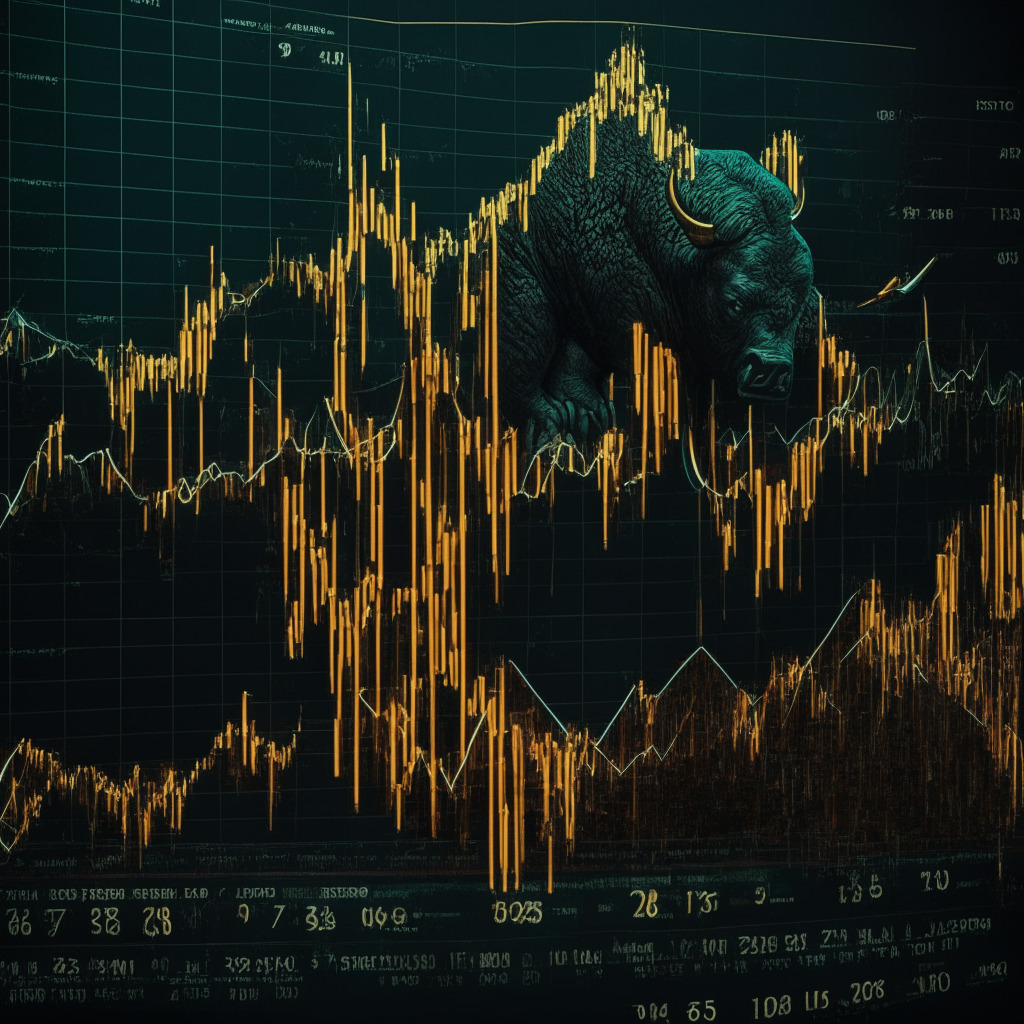Bitcoin (BTC), the largest cryptocurrency by market cap, cautiously operates within the $24,750-$28,500ish range, grappling with macroeconomic changes, institutional adoption issues, and a shifting regulatory landscape. Meanwhile, Ether (ETH) experiences a downturn, and traders explore volatility in low-cap coins. However, involvement with cryptocurrencies always carries high risk, and the information here doesn’t constitute investment advice.
Search Results for: Macro Markets
Macro Winds Drive Traders to Niche Markets: Highs and Lows in the Crypto Landscape
“As Bitcoin and Ether face resistance, traders are exploring niche markets, notably new coins like XDOGE and EmotiCoin. Rising newcomer, MoonDAO token, is drawing attention too. Alternatives to these include crypto presales, offering great potential returns, though with high risks.”
Bitcoin’s Calm Amid Stormy Legacy Markets: A Tale of Contrasting Market Conditions
Bitcoin’s price stability recently contrasted with a volatile U.S. dollar, almost mirroring a stablecoin. Despite these calm conditions, the U.S. dollar’s strength can cause market turbulence. Amid potential economic fluctuations, Bitcoin manages to maintain steadiness, prompting questions about the benefits of investing in traditional markets over emerging ones like Bitcoin.
Unpacking Project Atlas: A Centralized Perspective on Decentralized Markets
‘Project Atlas’, pioneered by Bank of International Settlements and various European Central banks, is developing a proof of concept system tracking on-chain and off-chain cryptocurrency transactions. The project aims to understand macroeconomic relevance of cryptocurrency markets and decentralized finance, offering transparency and potential risk mitigation.
Ethereum’s Uplift Amid Potential Futures ETF Launches and Macro Economic Factors
Today’s Ether price is getting a boost from projections of an Ethereum futures ETF launch and lower than expected inflation rates. The approval granted to asset manager Valkyrie to intertwine Ethereum futures within its Bitcoin Strategy ETF has also contributed to this bullish shift. However, traders must balance optimism with caution, acknowledging the inherent risks with every trading move.
Navigating Crypto Markets Amid Inflation Surges: A Roller-coaster Journey of Speculation and Risk
“The rising inflation and its potential impact on economic policies rattled crypto markets, leading to price volatility in Bitcoin. Despite the uncertain climate, some market participants remain optimistic, viewing risk, volatility, and speculation as essential lifelines of the crypto markets. However, due diligence remains a critical tool amidst these uncertainties.”
Navigating China’s Economic Woes: Uncertain Impact on Bitcoin and Global Markets
China’s economic struggles, apparent in July’s output deceleration and lower loan numbers, brew concerns for global economic growth. Particularly, investors fear China’s issues could negatively impact the U.S. dollar, commodities, and Bitcoin’s price. Amidst market uncertainty, the People’s Republic of China works to restore investor confidence with measures that, despite criticism of their short-term effectiveness, may impact Bitcoin’s future performance.
Understanding the Rising Tail-Risk Factor in Bitcoin Trading Amidst Macroeconomic Uncertainties
The recent increase of out-of-the-money call and put options associated with Bitcoin signals heightened vigilance among traders, anticipating what’s known as “tail risk”. This situation arises from concerns that Bitcoin’s value, already stagnating around $26,000, could abruptly shift due to an extreme event. Market data reflects this potential instability, despite outward price stability, tying into broader macroeconomic uncertainties.
Crippling $1 Billion Crypto Liquidation: Markets in Turmoil, Caution Urged
“A sudden slump in Bitcoin and Ether prices caused a frenzy in the cryptocurrency market, leading to large-scale liquidations and a loss of estimated $1B. As per Coinglass, 176,752 traders got liquidated within 24 hours. Market volatility, macroeconomic conditions, and range-trading tendencies have contributed to this downturn. Despite potential rewards, the inherent risks underscore the need for thorough research before investing.”
Bearish Wagers and Bullish Endeavours: Navigating Bitcoin’s Latest Slump Amid Macroeconomic Woes
“The flagship cryptocurrency, BTC, is currently embroiled in a surprising pullback amidst market apprehensions sparked by banking sector worries and a potential recession in China. Meanwhile, leverage funds have increased bearish wagers in cash-settled Bitcoin futures, indicating a possible shift of sentiment in the crypto space.”
Altcoin Season on the Horizon: A Dance between Technicals, Regulatory Challenges, and Macro Trends
The altcoin market is showing signs of an upcoming “alt season”, a phase where certain cryptocurrencies could outperform core players like bitcoin and ether. However, uncertainty surrounding crypto exchange’s compliance with security law and high yields from cash-equivalent money markets could impact these potential gains.
Inflation Rates and Their Impact on Crypto and Traditional Markets: A Guide to Understanding the CPI
The U.S. Consumer Price Index (CPI) data release could spotlight potential resurgence of inflation, affecting both traditional and crypto markets. The anticipated inflation rate easing could lead to a renewed confidence in risk assets, including Bitcoin. However, concerns of impending stagflation could disrupt conventional anticipations.
Bitcoin’s Struggle Amid Macroeconomic Factors: Is a Bullish Rebound Projected or Not?
“Bitcoin’s (BTC) stability remains unperturbed by the recent exploit with Curve Finance, as investors are urged to practice vigilant risk management. Although a significant price boost isn’t anticipated until 2024’s halving, BitBull Capital CEO, Joe DiPasquale, anticipates a prolonged positive market shift.”
Federal Interest Rate Hike and the Surprising Ignition of Cryptocurrency Markets
Cryptocurrency prices, including Bitcoin and Ethereum, have welcomed the anticipated interest rate increase by the U.S. Federal Reserve. Bitcoin experienced a 0.8% surge while Ethereum saw a 0.5% rise. According to Lex Sokolin of Generative Ventures, crypto’s overall story remains unaffected despite macroeconomic events. Equity markets show mixed responses, but further rate hikes might occur.
SEC and Crypto ETFs: A Future Game-Changer in Cryptocurrency Markets?
The SEC has invited public comments on a Bitcoin ETF proposition, ahead of the Federal Open Market Committee meeting in July. Amidst such events, Bitcoin maintains stability in the $30,000 support area. Applications for Bitcoin ETFs are being evaluated positively by the market, with public opinion eagerly awaited by the SEC.
Navigating the Crypto Course amidst the United States’ Macroeconomic Shocks
The crypto market closely watches upcoming U.S macroeconomic events. Despite a favorable swing in the CPI, the US central bank sticks to hiking the interest rate. The hawkish financial stance affects crypto prices, increasing investor concerns about central bank overreach. Other significant influences include retail sales, industrial productivity, home sales, and weekly jobless claims data.
Record Revenue with Bitcoin Miners: Thriving Markets of Q2 2023 Unraveled
“Bitcoin miners generated over $100 million from transaction fees in Q2 2023, a fivefold increase over last five quarters, revealing high demand for Bitcoin transactions. The surge in fee revenue is driven by Bitcoin’s recent price surge and the strategic adoption of BRC-20 token standard and Ordinals.”
Navigating Crypto Market Stability Amidst Macro-Economic Factors and Unexpected Turns
“Macro-economic factors significantly impact the crypto industry’s future, with potential effects on inflation and interest rates. Despite challenges, Bitcoin has rallied back, trading 9.1% higher than its Anchored Volume Weighted Average Price (AVWAP). Macroeconomic developments and widespread banking collapses could potentially impact these gains, while high credit balances and potential recessions bring additional uncertainty.”
Exploring the Volatility in Micro-Cap Cryptocurrency Markets During Major Market Calm
Over the Independence Day holiday in the US, Bitcoin and Ether maintained their impressive positions while the overall crypto market was relatively calm. The focus is on micro-cap cryptocurrency markets where volatility is unending, and traders are eager to find the ‘next big thing’. Coins in focus include Ksi Coin, Pepe 2.0 and Precipitate which have seen impressive fluctuations recently.
US CPI Data, Fed Policy Decision: Impact on Crypto Markets and Volatility
The upcoming United States CPI data and Fed’s policy decision could trigger sharp responses in equities and crypto markets. Meanwhile, Bitcoin whales accumulate more holdings despite price drop. Major cryptocurrencies need key support levels to hold for recovery amidst market volatility.
Asian Markets Rally Amid Fed Expectations: How Bitcoin Navigates Inflation and Volatility
Asian stock markets rally amid anticipation of the US Federal Reserve holding off on interest rate hikes, while Bitcoin trades below $27,000. Inflation concerns may lead to a surge in Bitcoin value as a safe haven. Investors should conduct thorough research before entering the volatile cryptocurrency market.
Summer Heatwave in Markets: US Dollar Surge vs Bitcoin’s Future Performance
The US Dollar’s remarkable uptrend since late April raises concerns due to its inverse correlation with Bitcoin (BTC). A continued dollar uptrend could affect BTC prices, but divergent signals suggest the rally may be nearing its end. Bitcoin whales have been increasing their holdings since April 17, coinciding with BTC’s year-to-date high.
Crypto and Equity Markets Dip: Impacts of Federal Reserves and Debt Deals Unveiled
As crypto and equity markets face a dip, Federal Reserve governors’ hawkish comments and debt deal signs have grabbed investor attention. Bitcoin has lost 3.2% in 24 hours, with ether declining by 2.8%. This month, Bitcoin may potentially register its first negative monthly return.
Asian Markets Open: Bitcoin in Red Amid Debt Ceiling Woes and Crypto Regulation Uncertainty
Bitcoin dips below $26,500 support amid debt ceiling stalemate, inflation, and crypto regulatory concerns. Ether and major cryptos also decline, while experts highlight shifting market risks and the convergence of crypto and traditional finance regulations.
Crypto Markets Tumble Amid US Debt Ceiling Fears and UK Inflation: Analyzing the Impact
Crypto markets faced a shake-up as concerns over UK inflation and Janet Yellen’s U.S. debt ceiling warning sent prices spiraling. The Federal Open Market Committee minutes revealed divided opinions on rate hikes, affecting investor confidence. Major cryptocurrencies, including Bitcoin and Ether, experienced significant declines, reflecting reduced investor optimism.
Navigating Crypto Markets Amid Bearish Trends & US Debt Standoff: Can Bulls Break Free?
A bearish market structure has reduced the cryptocurrency market capitalization to $1.13 trillion, with derivative metrics indicating a struggle for crypto bulls to break the downtrend. The U.S. debt ceiling standoff adds uncertainty, causing hesitancy among traders to bet on the market until more clarity is achieved. Derivatives metrics suggest bears remain in a comfortable position for now.
Crypto Adoption Surges in Emerging Markets: DeFi and Stablecoins Lead the Way
Mass crypto adoption is surging in emerging markets like Turkey, Colombia, Nigeria, and Argentina, where cryptocurrencies tackle pressing financial problems. Daniel Fogg explains that these nations lead in crypto adoption due to macroeconomic challenges and increased interest in decentralized finance (DeFi) solutions and stablecoins.
Unemployment Drops, Markets React: Crypto’s Growing Role in Economic Shifts
The recent decrease in weekly unemployment benefits and continuing claims has impacted U.S. stocks, with the Dow Jones Industrial Average falling and the cryptocurrency market experiencing a marginal decline. Stronger-than-expected jobless claims increase recession fears while the labor market remains highly competitive.
Bitcoin’s Holding Pattern: Macro Data, DeFi Developments, and Industry Challenges
Bitcoin and ether are trading in holding patterns despite macro data and Ethereum’s energy-efficient upgrade. Meanwhile, DeFi developments show promise, with Curve and Aave launching stablecoins soon. While challenges remain, the future of blockchain and digital assets is full of opportunities and uncertainties, requiring informed decision-making from investors.
Cryptocurrency’s Relationship with Macroeconomic Factors: Pros, Cons, and Future Impacts
Cryptocurrency markets remain responsive to macroeconomic changes despite being driven by technology and market sentiment, according to an S&P Global report. As interest from institutional investors grows, the relationship between crypto markets and macroeconomic indicators may strengthen, heightening contagion risks between traditional and crypto markets while also raising important questions about their future roles in global economies.
Bitcoin Stagnation: Examining Market Sentiments Amid Macroeconomic Concerns
Bitcoin price has recently remained within an 8.5% range, causing a drop in the 40-day volatility metric. Investors are losing their risk appetite due to factors like recession concerns and the U.S. debt ceiling issue. Bitcoin futures and options data suggest traders lack confidence, leaning towards sideways trading. This multifaceted environment may have driven investors towards fixed-income trades with higher interest rates.
Crypto Resilience Amid Fed Rate Hikes: Decoupling from Traditional Financial Markets?
The crypto market has shown remarkable resilience despite the Federal Reserve’s recent interest rate hike, with its market cap reaching $1.20 trillion. Cryptocurrencies may further decouple from traditional financial markets, as they develop increased immunity to macroeconomic uncertainties and exhibit long-term potential.































